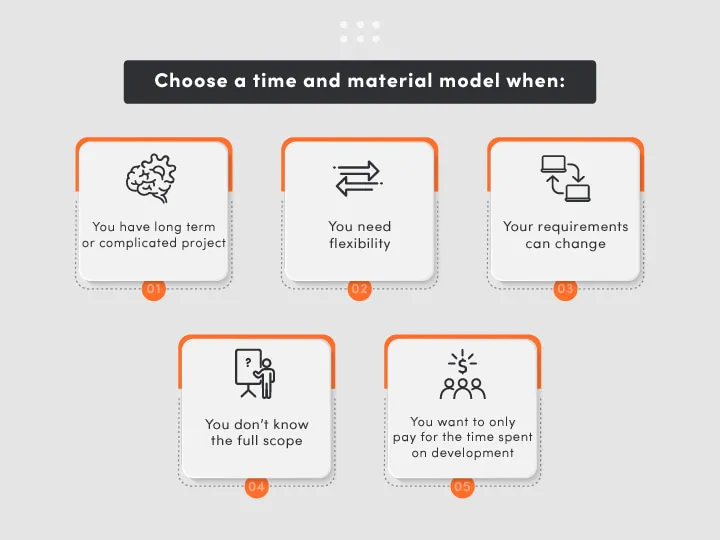When it comes to picking a cooperation model for outsourcing your next piece of software, you’ve got two options: the fixed price model vs the time and material model. But which is going to suit your business the best?
The answer to that question depends on a number of factors, but it’s super important to get right. Making the correct decision here could save you a whole bunch of money while at the same time, producing a better quality product in a shorter period of time.
Don’t just jump into whatever model your outsourcing agent of choice recommends. Take your time on this one! We’ve got all the information you could need to make the right decision on this coming right up.
What is a fixed-price model?

The more traditional model of the two is the fixed-price model. It’s also the easiest to understand, but these two features of it do not necessarily make it the best choice!
With fixed-price contracts, the agency you are outsourcing your work to will calculate the number of hours, developers and resources they will need and invoice you before they get underway. The money is usually one lump sum, and you’ll get what you pay for.
The simplicity here may sound appealing, and it really is. However, the easiness at the start does not always translate to positive results later down the line. These two advantages are worth bearing in mind, but you’ll note that there are quite a few disadvantages to consider as well.
Fixed-price contract disadvantages
Let’s take a look at some of the things that might get in your way should you choose to go for a fixed-price plan on your next software development endeavours.
- Higher cost of the project: with a fixed-price plan, you’ll need to make sure that you can trust your agency to be accurately estimating the price of the work, and this is not always the case, unfortunately. The scope of work (namely labor and materials) they invoice you could quite easily be ‘overestimated’. You can often check material costs, but less so those of labor.
- Longer preparation: having to specify all of your requirements right off the bat will cost you a lot more time upfront than you really need to be spending in a lot of cases. Pitching for a fixed price means that you will need to have everything decided in advance, and this can be really time-consuming.
- Worse response to changing conditions: a firm fixed-price contract means that you might not get the results you are looking for. Because it is so difficult to change anything, you won’t be able to be pragmatically engaged with the work, which means that it will be more difficult to respond to any changes of mind or extenuating circumstances later down the line.
- Lack of flexibility: being unable to curate your project as you go also means not only that you could well end up unhappy with the results, but also that things will take longer to be completed. Any small change that you need to pitch requires re-calculations on costs. The developer may also award fees for this as well, stretching your budget even further.
- Less accountability: the fact that you cannot control costs as easily with a fixed-price incentive contract is just one part of the lack of accountability this type of contract can be guilty of. You’ll also be more hard-pressed to find out if the project is going the way that you would like it to and to the time scale you are looking for.
When to go with a fixed-price contract
Fixed-price contracts aren’t all doom and gloom. If you’re confident that the project requirements will not change at any point, there is no reason to shy away from setting a fixed-price in theory. There are also a few other reasons that you might want to take up a fixed-price contract:
- When you see no changes being required at any point.
- If you’re confident that your tech stack will not need to be adjusted.
- If, for any reason, you need to ensure that your budget is not altered.
There are also clauses that can be put into this type of contract which help to balance out some of the disadvantages we discussed in the previous section. You might have heard of a fixed price contract with economic price adjustment. What this means is that the company will allow you to make a number of changes and be more liberal with the adjustments in cost to the plan that they make rather than handing out massive fees.
Try our developers.
Free for 2 weeks.
No risk. Just results. Get a feel for our process, speed, and quality — work with our developers for a trial sprint and see why global companies choose Selleo.
What is a time and material model?

Some software construction projects suit a different type of costing model, that of the time and material. Here, those outsourcing their software projects are likely to get more flexibility as billing here is based on the hourly rate of the work.
With this newer type of model, production or services are not set as a fixed price as they are in the alternative. The fixed hourly rates are the only costs set in stone for this mode, and potentially some material costs.
A time and materials (t&m) contract allows you to adjust your requirements on the fly (which, as anyone who has run a software project before knows, is likely to happen in most cases) which very much has the potential to save you money overall. But that’s not the only advantage here.
What are the biggest advantages of a time and material contract?
While the time and material contract model is certainly newer than that of a fixed-price version, it doesn’t mean it’s any worse. In fact, in a lot of cases, this newer, more flexible type of contract might actually be a lot better for a lot of projects or individuals.
Here are a few of the main benefits that CEOs and other members of a team can expect to experience when outsourcing their software development using time and material:
- Flexibility: perhaps the most exciting thing of all here is the fact that it will be much easier for you to change your mind. As we know, things come up and adaptations have to be made all the time, and the fixed-price model makes that difficult as we discussed earlier on. On the flip side, time and material makes this a whole lot easier.
- Time savings: this flexibility will save you time, too. No more admin fees for changes, and if the project works out to take less time than anyone thought it would originally, you’ll be spending less overall by paying as you go.
- Hourly labour costs: while it might require a bit more planning for the budget, the hourly labour costs will certainly save you money. You’ll know exactly where your money is going, which will help you to keep on track of your finances and stay in the black all the time.
- Dynamic workflow: here, we’re talking about scalability. Not only can the whole project be scaled backwards and forwards more easily, but individual sections of it can too. This means that you can do your best work when it is needed with the minimum of fuss. That’s a win-win for both you and the development agency.
What to consider before going for a time and material contract
If a time and material contract is beginning to look more appealing to you then this is good news. You’re on the first step to making your life a whole lot easier next time you need to have a piece of software created. However, a reasonable amount of planning is going to need to go into this before you get started (less so than fixed price-price contracts, by the way, as you won’t need to plan the whole project in one sitting). Here are a few tips.
- You’ll need to make sure that you have prepared all of the contracts required. The software outsourcing agency that you pitch to is going to want to know what you are expecting in terms of hourly rates and material costs.
- Understand exactly how the agency wants to play things. A meeting way ahead of time is always a good idea, so that you can get to know the team and the way that they like to run things.
- Take a look at the cost of materials. And we’re not just talking about physical items. Analyse the tech stack that is going to be required and find out how much this is going to cost so that you can add it into your budget.

When to choose a time and material model?
Still not sure that time and material is the right way to go for you? That’s understandable, it is new and fairly unusual to a lot of people still. We recommend taking up this type of contract plan in any of the following situations:
- Long-term or complex project: the longer and more complex a software project is, the more likely things are going to get in the way of it (requiring changes). Plus, these projects will of course cost more, so you’re probably going to want to save as much money as possible!
- You need flexibility: flexibility isn’t only needed for long or complicated projects. In fact, the majority of software projects these days will require some level of scalability based on all sorts of different factors.
- Your requirements can change: not only can extenuating circumstances affect the plan, but you might just have a change of heart. At these times, you’ll wish that you can change things easily.
- You don’t know the full scope: even more dramatic than the aforementioned circumstances is if you just do not know how long things are going to take. Here, it’s going to be almost impossible to calculate the cost of a fixed-price contract.
- You want to only pay for the time spent on development: do you have in-house developers that can take care of some of the work? Do you want to actually carry out some of the design work yourself, or with another company? A fixed-price contract is effectively not an option here.
Time and material model: how to do it right
Time and material contracts can require a little more research before you should get started. Don’t worry, there’s nothing scary about this! In fact, the right research can allow you to save even more money than you might have done in the first place.
Here are a few tips that we have to get you started as you embark on your quest to find the best time and material outsourcing client and how to make sure that they are right for you:
- Prepare your development specifications: you’re only going to have to plan the first week or two of your specifications, which requires a lot less work than a fixed-price contract. However, it’s important to make sure this is done right, as the developer will need to see it to get a feel for the work they are about to embark on.
- Do your homework: research, research, research. Finding the right developer is crucial to the success of your project, and we’re not just talking about finding the ones with the most accolades and skills. They’ll need to be right for you and your project specifically.
- Ask the right questions: a great way to find out if they are right for you is to sit down and interview them. Find out about their tech stack, any experiences they have with a similar project and how they work as a team to get things done.
- Check out previous pieces of their work: a portfolio of work is an excellent way to get a glimpse as to how well a company can perform as well as how similar the work looks in comparison to what you are expecting.
- Plan in partnership with your outsourcing partner: once you have selected an agency, make sure that you go through the first stages of planning together to make sure that you stay on the same page.
Summary
You might not have considered the option of taking up a time and material contract for your next project before today, but the fact that you have the option now is only going to put you in a stronger position as you move forward. Whether you do decide to take it up or not, having all the options at your disposal can only be a good thing.
But where do you go from here? It’s time to reach out for some consultations with software development companies. You can do that right here, with us at Selleo. We’re more than happy to talk to you about what we can do for you based on a time and material contracting model, so reach out for a free consultation with us today.





